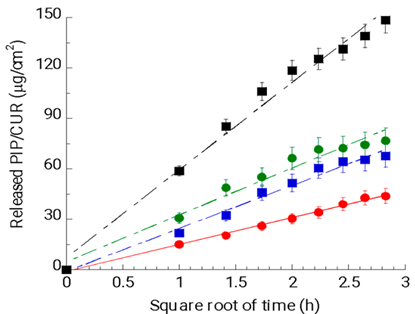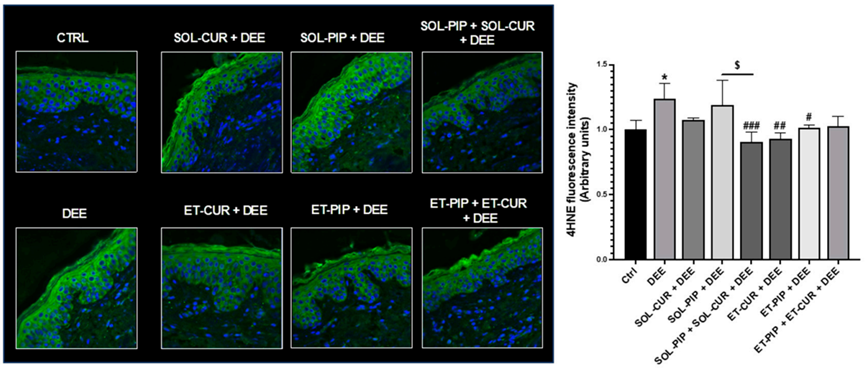Editor: Tiffany
Researchers have developed ethosomes to improve the delivery of curcumin and piperine, demonstrating their potential to protect the skin from damage caused by environmental stressors such as diesel particulate matter.
Key Highlights
- Research Question:
Can ethosomes enhance the cutaneous delivery of curcumin and piperine to prevent skin damage induced by environmental stressors like diesel particulate matter? - Research Difficulties:
Curcumin and piperine have poor bioavailability, low stability, and limited skin absorption, which hinder their therapeutic use. - Key Findings:
Ethosomes improved the stability and skin penetration of curcumin, provided controlled release, and, when combined with piperine, exhibited enhanced antioxidant activity and protection against skin damage. - Innovative Aspects:
The study utilized ethosomes as a delivery system for curcumin and piperine, demonstrating their ability to enhance drug penetration and provide synergistic protective effects against environmental stressors. - Importance of the Study:
This research offers a promising approach to protect the skin from environmental pollutants, addressing a significant public health concern related to skin disorders caused by air pollution.
Environmental Stressors and Skin Health
Environmental stressors, such as diesel particulate matter (DPM), pose a significant challenge to skin health. DPM, a mixture of gases and fine particles from diesel engine exhaust, is associated with skin disorders including atopic dermatitis, eczema, premature ageing, and melanoma. These effects are attributed to oxidative stress and inflammation, which impair the skin’s structural integrity and protective functions.
The skin serves as the body’s primary barrier against environmental pollutants, yet its defensive capacity may be limited under sustained exposure to stressors like DPM. Existing treatments, such as topical corticosteroids and moisturizers, are designed to alleviate symptoms but often face limitations in efficacy. Challenges include poor drug penetration through the skin’s outer layers and temporary symptom relief, alongside potential side effects, underscoring the need for alternative strategies to enhance skin protection.
Enhancing Delivery of Curcumin and Piperine Using Ethosomes
This study investigated the delivery of curcumin and piperine—natural compounds with antioxidant and anti-inflammatory properties—to the skin. Curcumin, extracted from turmeric, and piperine, derived from black pepper, have demonstrated potential in reducing skin damage. However, their application is hindered by low bioavailability, limited stability, and inadequate skin absorption.
Conducted by Francesca Ferrara, Agnese Bondi, and colleagues from the University of Ferrara, Italy, and published in 2024 in Antioxidants, the research aimed to improve the cutaneous delivery of curcumin and piperine using ethosomes—nanoscale vesicular systems intended to enhance drug penetration. The study focused on developing and evaluating ethosomal formulations to protect the skin from damage caused by environmental stressors, with an emphasis on DPM.
Formulation, Characterization, and Evaluation of Ethosomal Systems
1. Experimental Process Outline
- Preparation of ethosomes (ETs) using bulk cold method and microfluidic approach.
- Characterization of ETs for size distribution via photon correlation spectroscopy (PCS).
- Transmission electron microscopy (TEM) analysis for morphology assessment of ETs.
- Measurement of drug entrapment capacity using ultrafiltration and high-performance liquid chromatography (HPLC).
- In vitro release tests (IVRT) using Franz diffusion cells for drug release evaluation.
- In vitro permeation tests (IVPT) to assess skin permeation of drugs from ETs.
- Ferric reducing antioxidant power (FRAP) test to evaluate antioxidant activity of formulations.
- Ex vivo studies on human skin explants exposed to diesel engine exhaust (DEE) after treatment with ETs.
- Patch test on human volunteers to assess irritation potential of drug-loaded ETs.
2. Key Experiments Introduced
1. Preparation and Characterization of Ethosomes
- Procedure: Ethosomes were prepared using both a bulk cold method and a microfluidic approach. The bulk method involved solubilizing phosphatidylcholine (PC) in ethanol and adding distilled water dropwise while stirring. The microfluidic approach utilized a cross-junction chip to mix the lipid and aqueous phases. The size distribution of the resulting ethosomes was measured using PCS, and their morphology was analyzed via TEM.
- Result: Both preparation methods produced ethosomes with a mean diameter of approximately 200 nm, with a dispersity index indicating a homogeneous size distribution. TEM images showed spherical or ovoid nanovesicles with a multilamellar structure.
- Finding: The bulk cold method was found to be more efficient for producing ethosomes, yielding larger volumes in a shorter time without affecting size and morphology.
2. Drug Entrapment Capacity and Release Kinetics
- Procedure: The entrapment capacity of curcumin (CUR) and piperine (PIP) within the ethosomes was quantified using ultrafiltration followed by HPLC analysis. The release kinetics were evaluated through IVRT using Franz diffusion cells with PTFE membrane to separate donor and receptor compartments.
- Result: The study showed an entrapment capacity of approximately 96.87% for CUR and 78.95% for PIP. During the IVRT, CUR was released more slowly than PIP, with cumulative release percentages indicating a controlled release profile.
- Finding: CUR demonstrated a higher retention within the ethosomes compared to PIP, which suggests that ethosomes can effectively sustain the release of CUR over time, potentially enhancing its therapeutic efficacy.

Figure 1. Release kinetics of curcumin (CUR) and piperine (PIP) from ethosome formulations (ET–CUR and ET–PIP) compared to their respective solutions, demonstrating controlled release profiles over time.
3. Antioxidant Activity Assessment
- Procedure: The antioxidant activity of the ethosome formulations (ET–CUR and ET–PIP) was evaluated using the FRAP test, comparing the formulations to their respective drug solutions.
- Result: The FRAP assay indicated that CUR retained its antioxidant activity when loaded in ethosomes, while the combination of ET–CUR and ET–PIP showed a statistically significant increase in antioxidant power compared to CUR alone.
- Finding: The results suggest that the ethosome formulation not only preserves the antioxidant properties of CUR but also enhances the overall antioxidant effect when combined with PIP.

Table 1. Antioxidant activity of the indicated formulations.
4. Ex Vivo Skin Protection Studies
- Procedure: Human skin explants were pre-treated with ethosomes and then exposed to diesel engine exhaust (DEE) for 60 minutes. The levels of oxidative stress markers (4HNE), filaggrin, and type I collagen were assessed post-exposure.
- Result: Ethosome treatments significantly reduced 4HNE levels, indicating decreased oxidative damage, and maintained higher levels of filaggrin and type I collagen compared to untreated controls.
- Finding: The ethosome formulations effectively protected human skin from oxidative and structural damage induced by environmental pollutants, highlighting their potential in skin care applications.

Figure 2. Immunofluorescence staining results showing levels of 4-hydroxy-nonenal (4HNE) in human skin explants treated with ethosomes and exposed to diesel engine exhaust (DEE), indicating effective reduction of oxidative damage.
Ethosomes as a Promising Delivery System for Skin Protection
This study highlights the utility of ethosomes as a delivery system for curcumin and piperine to safeguard the skin from environmental stressors, notably diesel particulate matter. The ethosomal formulations enhanced the stability and bioavailability of these compounds, facilitating their penetration into the skin and amplifying their antioxidant activity. Conducted by the University of Ferrara team, this research advances the application of nanotechnology-based systems for skin protection, offering a viable approach to counter the effects of environmental pollutants.
Reference:
Ferrara, Francesca, et al. “Ethosomes for curcumin and piperine cutaneous delivery to prevent environmental-stressor-induced skin damage.” Antioxidants 13.1 (2024): 91.
